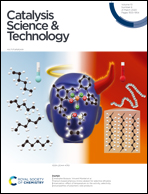Use of titanocalix[4]arenes in the ring opening polymerization of cyclic esters†
Abstract
The known dichloride complexes [TiCl2L(O)2(OR)2] (type I: R = Me (1), n-Pr (2) and n-pentyl (3); L(OH)2(OR)2 = 1,3-dialkyloxy-p-tert-butylcalix[4]arene), together with the new complexes {[TiL(O)3(OR)]2(μ-Cl)2}·6MeCN (R = n-decyl (4·6MeCN)), and [Ti(NCMe)Cl(L(O)3(OR))]·MeCN (type II: R = Me, 5·MeCN) are reported. Attempts to prepare type II for R = n-Pr and n-pentyl using [TiCl4] resulted in the complexes {[TiL(O)3(On-propyl)]2(μ-Cl)(μ-OH)} 6·7MeCN and {[TiL(O)3(On-pentyl)]2(μ-Cl)(μ-OH)}·7.5MeCN (7·7.5MeCN), respectively; use of [TiCl4(THF)2] resulted in a co-crystallized THF ring-opened product [Ti(NCMe)(μ3-O)L(O)4TiCl(O(CH2)4Cl)]2–2[TiCl(NCMe)(L(O)3(On-Pr))]·11MeCN (8·11MeCN). The molecular structures of 2·2MeCN, 4·6MeCN, and 5·MeCN together with the hydrolysis products {[TiL(O)3(OR)]2(μ-Cl)(μ-OH)} (R = n-Pr 6·7MeCN; n-pentyl, 7·7.5MeCN, 9·9MeCN); R = n-decyl 10·8.5MeCN) and that of the ring opened product 8·11MeCN and the co-crystallized species [Ti2(OH)Cl(L(O)3(OR))][L(OH)2(OR)2]·2.85(C2H3N)·0.43(H2O) (R = n-pentyl, 11·2.85(C2H3N)·0.43(H2O)) are reported. Type I and II complexes have been screened for their ability to act as catalysts in the ring opening polymerization (ROP) of ε-caprolactone (ε-CL), δ-valerolactone (δ-VL), ω-pentadecalactone (ω-PDL) and rac-lactide (r-LA), both with and without benzyl alcohol present and either under N2 or in air. The copolymerization of ε-CL with δ-VL and with r-LA has also been investigated. For the ROP of ε-CL, all performed efficiently (>99% conversion) at 130 °C over 24 h both under N2 and in air, whilst over 1 h, for the type I complexes the trend was 3 > 2 > 1 but all were poor (≤12% conversion). By contrast, 5 over 1 h at 130 °C was highly active (85% conversion). At 80 °C, the activity trend followed the order 5 ≈ 4 > 3 > 2 > 1. For δ-VL, at 80 °C the activity trend 5 ≈ 4 > 1 > 2 > 3 was observed. ROP of the larger ω-PDL was only possible using 5 at 130 °C over 24 h with moderate activity (48% conversion). For r-LA, only low molecular weight products were obtained, whilst for the co-polymerization of ε-CL with δ-VL using 5, high activity was observed at 80 °C affording a polymer of molecular weight >23 000 Da and with equal incorporation of each monomer. In the case of ε-CL/r-LA co-polymerization using 5 either under N2 or air, the polymerization was more sluggish and only 65% conversion of CL was observed and the resultant co-polymer had 65 : 35 incorporation. Complex 5 could also be supported on silica, however this system was not as active as its homogeneous counterpart. Finally, the activity of these complexes is compared with that of three benchmark species: a di-phenolate Ti compound {TiCl2(2,2′-CH3CH[4,6-(t-Bu)2C6H2O]2)} (12) and a previously reported NO2-containing titanocalix[4]arene catalyst, namely cone-5,17-bis-tert-butyl-11,23-dinitro-25,27-dipropyloxy-26,28-dioxo-calix[4]arene titanium dichloride (13), as well as [Ti(Oi-Pr)4]; the parent calixarenes were also screened.
![Graphical abstract: Use of titanocalix[4]arenes in the ring opening polymerization of cyclic esters](/en/Image/Get?imageInfo.ImageType=GA&imageInfo.ImageIdentifier.ManuscriptID=C9CY02571E&imageInfo.ImageIdentifier.Year=2020)
- This article is part of the themed collection: 2020 Catalysis Science & Technology Hot Articles


 Please wait while we load your content...
Please wait while we load your content...